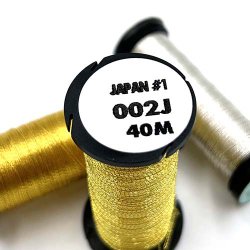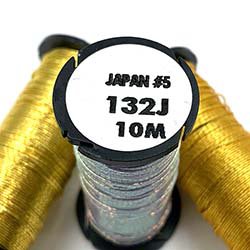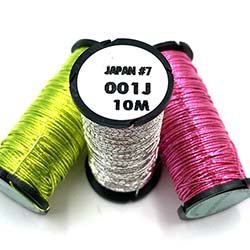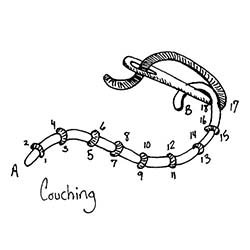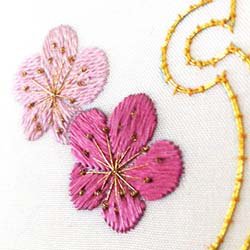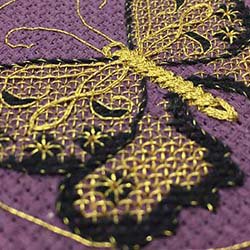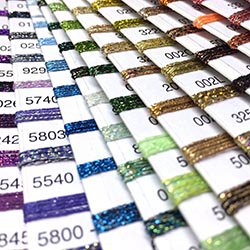Japan Threads
Smooth, bright metallic gimps designed like traditional Japan thread—a metallic wrapped around a core fiber—but made of modern materials rather than real gold or silver. Couch these elegant fibers onto any design. Japan #7 is thicker than Japan #5. Both can be couched with the super thin Japan #1 or a silk thread like Kreinik Silk Bella. Dry clean only.
-
Couching
Where to use it:
In cross stitch, needlepoint, surface embroidery and counted thread designs where you want to attach a real metal thread, or a larger item like a thick thread or cording, and in traditional Japanese embroidery.
What to couch:- Kreinik 1/8" Ribbon & 1/16" Ribbon
- Kreinik Heavy #32 Braid, Canvas #24 Braid & Medium #16 Braid
- Kreinik Japan #5 & Japan #7
- Kreinik Japan colors in #16 Braid, 1/16" Ribbon, and 1/8" Ribbon
- Kreinik Torsade
- Kreinik real metal threads
- Kreinik Facets & Petite Facets
Use these finer threads to couch the thicker ones:
- Kreinik Cord
- Kreinik Japan #1
- Kreinik Silk Bella
- Kreinik Silk Couching Thread
How to do it:
Follow the diagram for needle and stitch placement. Plunge the end of your thicker thread into the fabric at A, securing the ends on the back of your fabric with a few stitches, or temporarily taping the end. To couch, come up at 1, down at 2, up at 3, down at 4, etc. When finished, plunge the end into the fabric at B, and secure end on the back of your fabric with a few stitches.

Alternative:
Designer and teacher Anna-Marie Winter taught us that you can also couch a thicker thread by inserting your tacking stitches down the center of the larger thread, rather than side-to-side as in the traditional instructions above. This enables you do make curves and corners more easily.
WATCH how to couch in needlepoint:
-
The History Of Japan Threads
Historically, Japan thread embroidery began in China with gold, silver, and copper metalwork. Gold and silver yarns were made by pounding gold and silver stock into extremely thin leaf, which was sliced into very narrow strips and then rolled around a core and twisted into yarn. With time, the gold yarn was modified to a gilt yarn, which was silver with a gold overlay.
The Japanese later developed a method of making metal threads by depositing a coating of gold or silver on rice paper, which was then cut into fine strips and wrapped around a thread core. This became known as Japan Gold or Japan Silver. However, dampness caused the rice-paper backing to deteriorate. Modern technology has eased the process of making Japan threads, and Kreinik now offers Japan Threads in a variety of thread sizes for hand and machine embroidery.
Kreinik Japan Threads are synthetic, non-tarnishing gimps available in gold, dark gold, silver and copper that give the appearance of stitching with real gold, silver or copper. Since real metal threads are rare and expensive, Japan Threads are an ideal substitute. Japan Threads are available in Super Fine #1, Fine #5, and Medium #7 sizes, also Very Fine, Fine, Tapestry, and Medium Braids plus 1/16" and 1/8" Ribbons and 3/8" Trim.
Japan threads in the Kreinik line are indicated by a "J" following the color number, as in 002J.
-
How to use Kreinik Japan Threads
In the Kreinik thread line, “Japan Thread” refers to a modern version of an historical fiber. Centuries ago, artisans pounded real gold into flat pieces that were wrapped around horse hair, then couched onto fabric for rich, elegant embroidery. Today, we make a similar type of thread but with less expensive materials. If you want to recreate the supreme elegance of real metal thread embroidery, or historical Japanese embroidery, Kreinik’s Japan Thread line is an ideal place to start.
1. Basic Kreinik Japan Threads come in three sizes:
- Japan #1
- Japan #5
- Japan #7
- Smooth, bright, and shiny, they give the look of stitching with real metals.
2. The smaller the number, the thinner the thread:
- Kreinik Japan #1 is super fine, very thin, the thinnest.
- Kreinik Japan #5 is slightly thicker.
- Kreinik Japan #7 is thicker than #5.
3. Stitch with one, couch the others:
- Japan #1 is a passing thread; stitch through fabric as you would a sewing thread.
- Japan #5 and #7 are gimps, or wrapped threads, and therefore couched onto the surface rather than sewn in and out of fabric. The metallic foil is wrapped around a core fiber, so if you stitch and and out with Japan #5 and #7, the wrapping may separate or come off. You can use it in long stitches in needlepoint or embroidery, as long as the fabric you're using is an open weave or open canvas, and the stitches aren't compact.
- Japan #5 and #7 can be couched singly or multiple strands at a time for unique effects. Couch with a matching color of Japan #1, or a contrasting color of metallic or silk thread depending on the look you want to achieve.
4. Kreinik also makes Japan Threads in Braids, Ribbons and 3/8" Trim:
- This gives stitchers/weavers/fiber-
artists more Japan Thread textures (ie, creative options). A Japan Thread in Kreinik Tapestry #12 Braid, for instance, looks like a checked or serpentine metal thread. - They are thicker, stiffer, and more texturized than the basic Japan Threads. They are best in long stitches or stitches that are more open (not compact) in needlepoint, counted thread, crazy quilting, temari, crochet, and surface embroidery techniques.
- Look for a "J" after the color number, as in 002J or 001J.
- The smaller the Braid number, the smaller the thread. Kreinik Very Fine #4 Braid is the thinnest Braid, for example, and Fine #8 Braid is twice as thick as #4 Braid.
- Kreinik 3/8" Trim, made out of Japan threads, comes in wired version or unwired. This trim is lovely for edging, or couch onto a design (experiment with attaching beads down the center of the woven ribbon).
5. Kreinik Japan Threads are easier to care for than their historical counterparts:
- This generation of Japan Thread is synthetic and thus less expensive and more readily available than real metal threads.
- They have a percentage of real metal, but are non-tarnishing—as long as you don't wrap them with rubber bands! (see below)
- You can dry clean needlework made with Kreinik Japan Threads.
6. One thing you must NEVER do with Japan threads: put rubber bands around the spools. Japan Threads have a small percentage of real metal in the raw material, which can react with the rubber in the band. It will ruin your thread.
Side note on couching Japan Threads: A squared-off spool known as a Koma is often used to hold the thicker Japan Threads or other couching threads as you stitch. The Koma won't roll off like round spools, and you can unwind thread as you couch.



